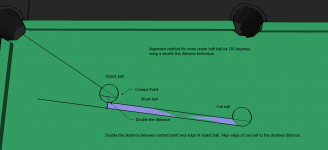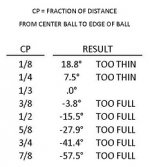I developed this technique after investigating how contact point aiming is done. I aimed at the contact point with the center of the cue ball, but compensated mentally with a different alignment to pocket the ball. I was figuring out how to make the shot with information from my eyes and subconsciously aiming on a different line.
I figured this out by aiming at the contact point and then stopping to see where I was really lined up to in order to pocket the ball. If I would have shot directly at the contact point, I would have under or over cut the ball. I found I was fractionally aligning the cue ball to the object ball in this reverse double distancing method. As long as I move into the shot and maintain this visual setup, I don't have to aim at anything. I am lined up to pocket the ball.
Best,
Mike


